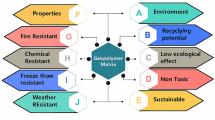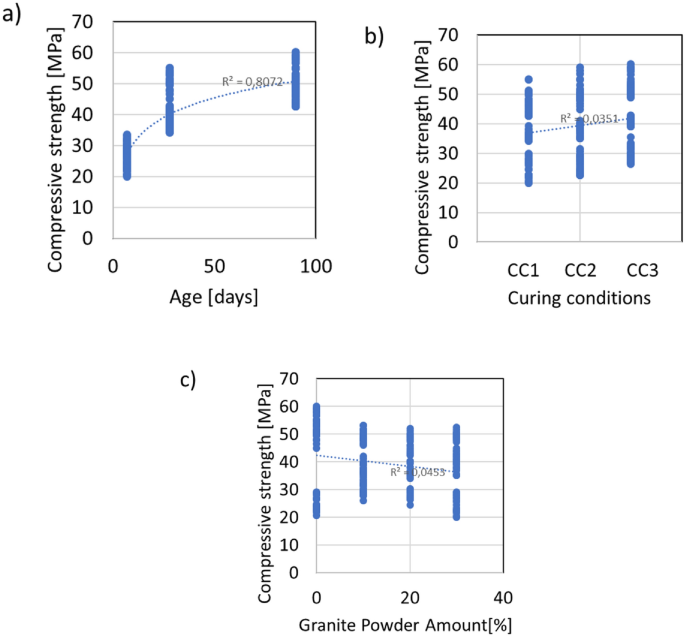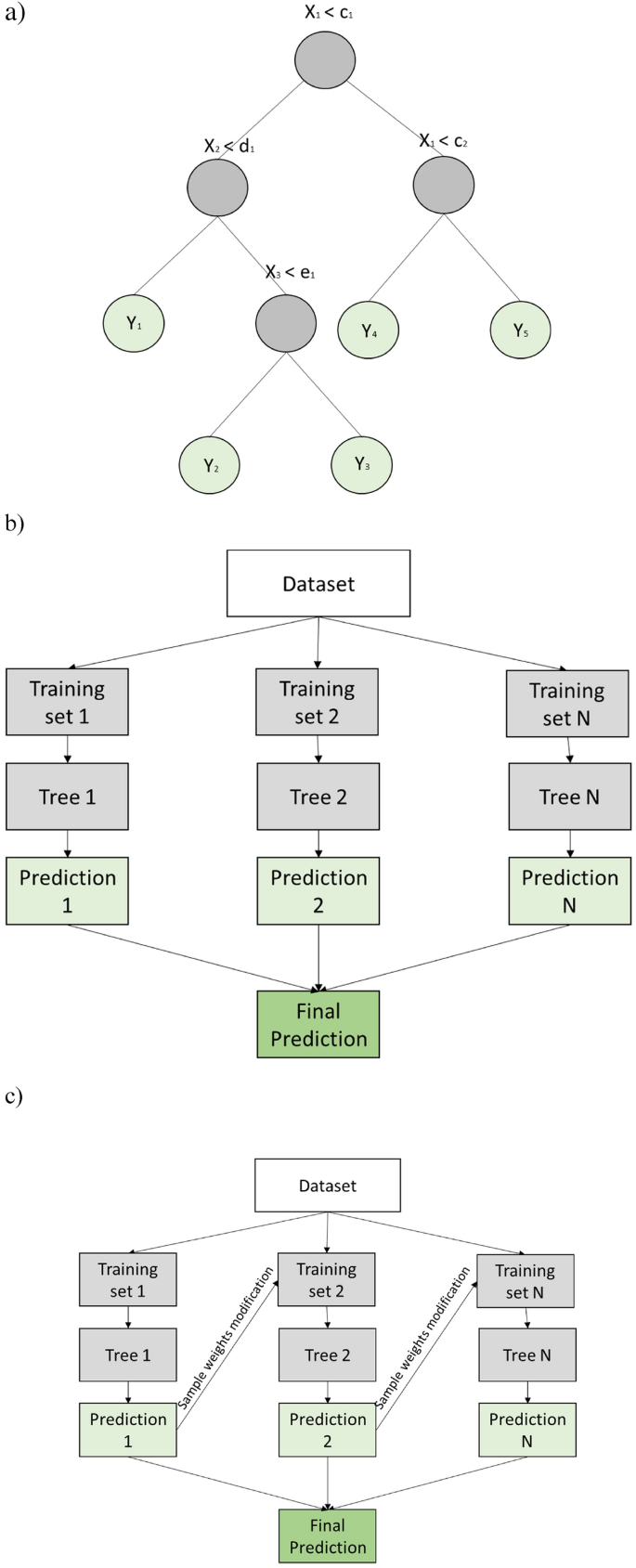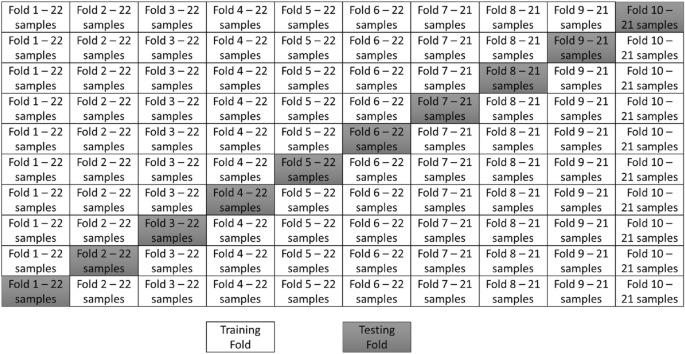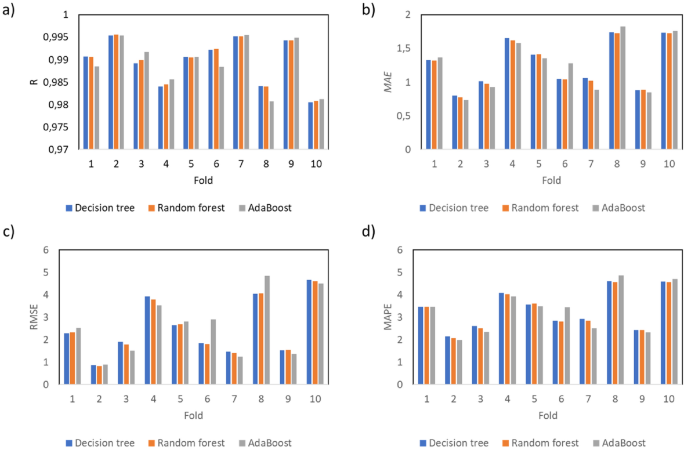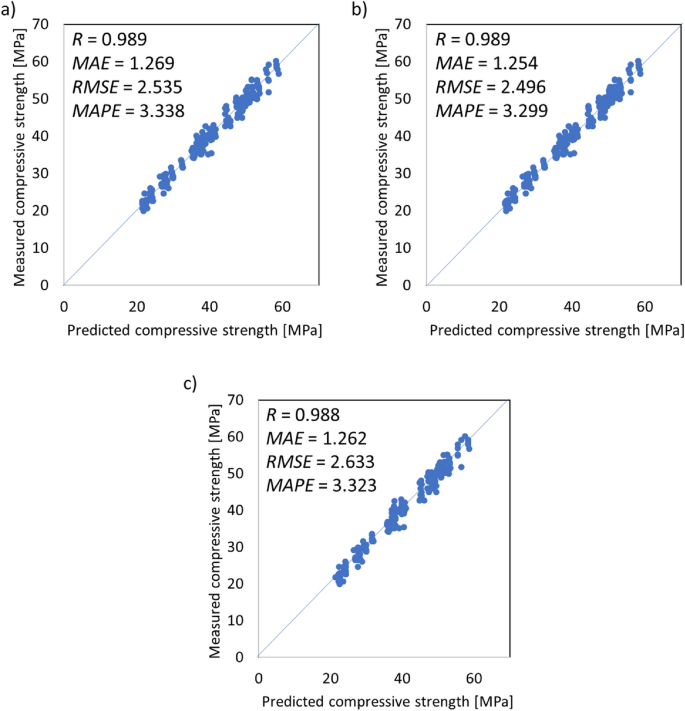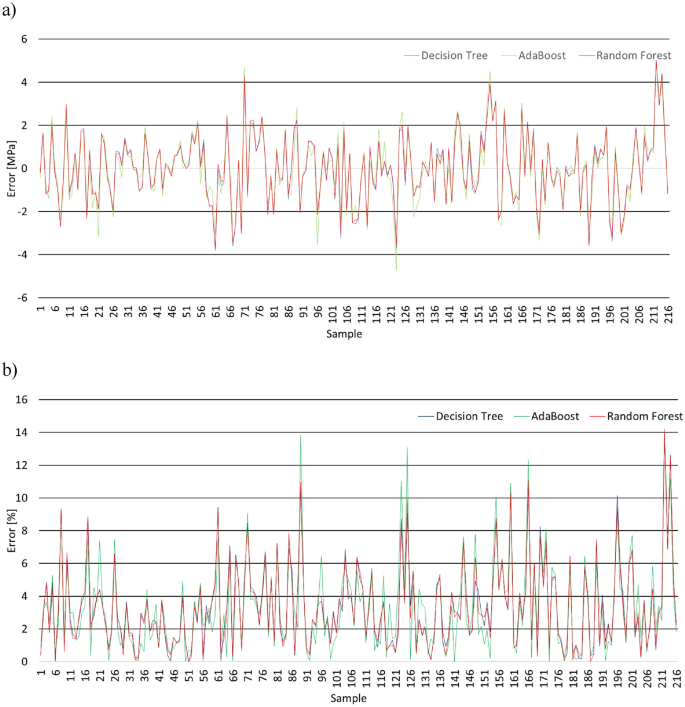Abstract
In this study, a machine learning model for the precise manufacturing of green cementitious composites modified with granite powder sourced from quarry waste was designed. For this purpose, decision tree, random forest and AdaBoost ensemble models were used and compared. A database was created containing 216 sets of data based on an experimental study. The database consists of parameters such as the percentage of cement substituted with granite powder, time of testing and curing conditions. It was shown that this method for designing green cementitious composite mixes, in terms of predicting compressive strength using ensemble models and only three input parameters, can be more accurate and much more precise than the conventional approach. Moreover, to the best of the authors' knowledge, artificial intelligence has been one of the most effective and precise methods used in the design and manufacturing industry in recent decades. The simplicity of this method makes it more suitable for construction practice due to the ease of evaluating the input variables. As the push towards decreasing carbon emissions increases, a method for designing green cementitious composites without producing waste that is more precise than traditional tests performed in a laboratory is essential.
Similar content being viewed by others
Introduction
The application of admixtures in the manufacturing of so-called 'green cementitious composites' has recently played a more important role in sustainable development. This is mainly due to the recent worldwide trend towards reducing the amount of carbon dioxide (CO2) generated during the production of Portland cement1,2. These composites are “green” because of the incorporation waste admixtures and as a partial replacement for cement. Such admixtures mainly include fly ash, ground granulated blast furnace slag (GGBFS), and granite powder3,4,5. An additional reason for their use is the fact that these materials are waste from various industrial processes6.
The use of granite powder as an admixture in mortars is mainly of interest because this material is difficult to recycle. Usually, this waste mineral is stored but has a decomposition time greater than 1,000,000 years. Granite is extremely hazardous in powder form because the powder particles are often suspended in the air and enter soil and water. Thus, mineral waste powders have the potential to cause respiratory failure in humans and animals. Furthermore, its disposal leads to water pollution and plant pollination (which is detrimental to the environment). The incorporation of waste mineral powders into solid material (such as mortar or concrete) reduces its hazardous effects, mitigating their harmfulness7. Recently, an increasing number of studies have focused on the behaviour of cementitious composites containing granite powder. This research is particularly related to the mechanical properties of hardened cementitious composites (e.g., compressive strength8, flexural strength9, tensile splitting strength10).
The conventional methodology for identifying the compressive strength of cementitious composites requires destructive laboratory tests. Unfortunately, these tests are very costly and time-consuming. For example, in the European Union, it costs no less than 100 euros to test one series of composites. Because these tests are destructive, they are performed on a limited number of samples, which may lead to imprecise results. This makes the conventional methodology ineffective and increases the carbon footprint of the process of obtaining mechanical properties. Furthermore, because with traditional methods11, the ability to evaluate the compressive strength of mortar containing a large amount (above 15% of the cement mass) of granite powder as a substitute for cement is lacking, a more precise method is needed. To the best of the authors' knowledge, artificial intelligence has been one of the most effective and precise methods used in the design and manufacturing industry in recent decades.
To overcome the disadvantages mentioned above, modelling methods based on machine learning algorithms are used more frequently to address various engineering problems (e.g., the prediction of the compressive strength12, adhesion between cementitious composite layers13, soil compression coefficient14, soil erosion susceptibility15, and axial compression capacity16 and the design of concrete mixtures17). Such modelling, using machine learning, consists of 5 steps: problem definition, data collection, modelling, evaluation and result analysis18.
Of these techniques, artificial neural networks (ANNs) are especially popular. In previous research, ANNs have been very useful for predicting the compressive strength of cementitious composites19,20,21 and have been used to determine the compressive strength of lightweight cementitious composites22 and cementitious bricks23, as well as the compressive strength of self-compacting composites24. However, such research is still needed for green cementitious composites containing different admixtures. First, the behaviour of such composites under various loading conditions should be determined. In particular, these admixtures affect the compressive strength of composites. Additionally, because creating machine learning-based models for compressive strength prediction is a nondestructive way of identifying these properties, it would reduce the associated costs and time for companies producing concrete. Daily, tons of concrete are wasted because of compressive strength tests due to the requirements of the standards imposed and the obligation to test all parts of a hardened concrete mixture, in some cases once a day25.
However, more recently, studies have been undertaken to use ensemble models due to their very high precision and good performance in predicting the compressive strength of concrete. This is because a random forest rejects linear assumptions and is able to learn the importance of inconsistent variables in datasets26. Notably, most ensemble models are characterized by higher overfitting resistance. Therefore, various ensemble models have been used, e.g., for the prediction of the compressive strength of cementitious composites27. These models have also been used successfully to predict the compressive strength of cementitious composites containing recycled rubber28, blast furnace slag, silica fume29 and fly ash30.
However, ensemble models for predicting the compressive strength of cementitious composites (cement paste, mortar, or concrete) where the cement is replaced by the waste granite powder are still lacking. This is a research gap that should be filled and is a goal of this article.
Materials and methods
Mixing proportions
In this study, ordinary Portland cement (OPC) and granite powder (GP) were used as binders. The physical and chemical properties of the cement and granite powder are described in Table 1 and Fig. 1, respectively. The particle size distributions of ordinary Portland cement and granite powder were investigated by means of the sieve size development method. Both materials were placed on a sieve assembly and then shaken for 180 s. Then, the residue on each sieve was weighed, and a screening curve was created. The particle size distributions of ordinary Portland cement and granite powder are compared in Fig. 1. River sand with a fineness modulus of 2.40, a specific gravity of 2.45, and a water absorption of 0.82 was used as the fine aggregate. In the present investigation, potable water was used for mixing and curing.
In this research, 4 series of cement mortars were prepared, the compositions of which differed in the amount of cement replaced with granite powder (GP). Details of the proportions of the mortar mix by weight used in this study are presented in Table 2.
Experimental program
Figure 2 presents the research procedure. First, the dry ingredients were placed in a mixer and mixed for 30 s. Then, water was added, and the mixture was mixed for 90 s. Next, the mortar remnants on the walls of the mixer were manually peeled off, and the mixture was mixed for 90 s.
After mixing, the consistency of the mortar was investigated using the mortar slump subsidence method31, and then the mortar was placed in prepared forms. Twenty-four hours after moulding, the sample curing process started. The samples were divided into 3 groups and then stored according to the conditions described in Table 3.
After 7, 28, and 90 days of curing, the samples were investigated by a compressive strength test. Compressive strength tests were performed using a compression strength test machine (Fig. 2) according to32.
Results
Statistical analyses of the obtained results
In the experimental program, only three variables were varied: age (7, 28 and 90 days), curing conditions (air cured, humid-air cured, and water cured) and water to cement ratio (0.5, 0.56, 0.63, and 0.71) as an expression of the decreasing amount of cement and increasing amount of granite powder. Thus, because the compression tests were performed on 2 halves after the tensile strength tests, the overall number of investigated samples was 216. In Fig. 3, the results of the compressive strength are presented with respect to age, curing conditions, and water-to-cement ratio.
According to Fig. 3, there is only a correlation between age and compressive strength. This is supported by the value of the coefficient of determination, which is equal to R2 = 0.807. For the other variables and the compressive strength, there is a lack of correlation, as evidenced by the very low values of the coefficient of determination, which are less than R2 = 0.4. As expected, the highest compressive strength values are obtained for the samples that were kept in water; their curing conditions are denoted as CC1. The older the samples are, the higher the value of the compressive strength obtained. However, the addition of the granite powder is unable to obtain compressive strength values equal to the 60 MPa of the reference sample, but due to the filling effect of the powder, the minimum values of compressive strength increase with increasing granite powder content (from approximately 20 MPa to 28 MPa for 10% replacement of cement by granite powder and to 25 MPa for 20% replacement of cement by granite powder). This effect is very promising for the design of low-quality cementitious composite mixtures.
Modelling the compressive strength by means of ensemble models
As mentioned above, there are no strong correlation between the variables that are components of the mixture proportions, curing conditions, or testing age and compressive strength. Thus, it is reasonable to perform numerical analyses using more sophisticated techniques, e.g., ensemble models.
These models based on decision trees, which are considered supervised machine learning algorithms, are able to solve both regression and classification problems. The structure of such a decision tree consists of nodes in which a binary decision is made, and this division continues until the moment the algorithm is not able to separate the data in the node33. This node, called the leaf of the tree, provides the solution of the problem. The advantage of using this type of algorithm is the simplicity of the model obtained. However, in contrast, this is also a disadvantage because it might lead to algorithm overfitting. Decision trees are accurate and perform well on datasets with large variations in variables and when the number of records is not large34.
This problem might be solved by using a random forest algorithm, which uses many decision trees to obtain the solution to one problem. Each tree in the forest is built by a random training set, and at each node, division is carried out based on input variables that are randomly selected35.
However, in some cases, the performance of the random forest algorithm is not accurate, and efforts to improve it should be made. For this purpose, of the various ensemble learning algorithms, the adaptive boosting (AdaBoost) algorithm is the most typical and widely used36. This algorithm is effective because the next tree in the algorithm is modified based on the precision of the previous tree, strengthening the learning ability. The structural scheme of a decision tree, where the input variables are denoted Xi and the output variable is denoted Yi, is presented in Fig. 4 combined with the random forest and AdaBoost algorithm schemes.
The level of precision of the models is evaluated using a few parameters, which, according to37, can include the linear correlation coefficient (R), mean absolute error (MAE), root mean squared error (RMSE), and mean average percentage error (MAPE). The calculations of these parameters are performed as follows:
where y, measured value from the experimental test; \(\hat{y}\), predicted value from the analyses; \(\overline{y}\), mean value; n, number of data samples in the process.
Note that an R value closer to 1 corresponds to a better prediction from the algorithm. In turn, lower values of MAE and RMSE and MAPE mean that the algorithm predicts the output variables better than the other algorithms. Additionally, to avoid overfitting, tenfold cross-validation is performed according to38, as presented in Fig. 5.
Based on the division of the dataset presented in Fig. 5, numerical analysis is performed. The performance of each fold is evaluated and presented in Fig. 6 in terms of the values of R, MAE, RMSE and MAPE. Moreover, the relations between the experimentally measured compressive strength value and those obtained using machine learning algorithms are presented in Fig. 7, combined with the error distribution in Fig. 8.
According to Figs. 6, 7 and 8, all of the investigated ensemble models are significantly precise in terms of predicting the compressive strength of mortar containing waste granite. This is evidenced by the very high values obtained for the linear correlation of coefficient R, which are close to 1.0. The accuracy of the performance is also supported by the very low errors values, which, as shown in Fig. 7, are less than 4%. Additionally, according to Fig. 8, the proposed models accurately predict the compressive strength values and only fail to properly predict the strength of a few samples (the percentage error is higher than 10%).
The proposed model is also accurate compared to other machine learning algorithms used for the purpose of predicting the compressive strength of green cementitious composites containing different admixtures. Some selected works are presented in Table 4 in addition to the results obtained by the models presented in this work.
Analysis of the results in Table 4 shows that the levels of precision for the compressive strength of green cementitious composites using machine learning algorithms are very high. Additionally, in this work, a very precise model for predicting the compressive strength of green cementitious composite containing different admixtures, in comparison to those investigated previously, is constructed.
Conclusions
In this article, a comparison of three ensemble models for predicting the compressive strength of mortars containing waste granite powder, taking into account the age of the samples and the curing conditions, was presented. For this purpose, a database was built based on an experimental program. This database was formulated on the basis of tests performed on standardized samples prepared and tested at different ages and cured under different conditions. Based on the presented research, the following conclusions can be drawn:
-
The article shows that it is possible to predict the compressive strength of mortars with granite powder additions based on just three parameters: the testing age, the water to cement ratio and the curing conditions. Therefore, the presented method can be seen to be simple and reliable in use.
-
The usefulness of this method was proven by the very high values of the linear correlation coefficient R, which equal 0.989 for the decision tree, 0.989 for the random forest and 0.988 for AdaBoost.
-
All models were characterized by low error values, which in the case of MAE were less than 1.270 MPa, in the case of RMSE were less than 2.633 MPa, and in the case of MAPE were less than 3.35%.
The authors emphasize that the proposed method has limitations, which include the time of the test and the water-to-cement ratio. However, the only curing conditions that were not taken into account in this paper were characterized by high temperature; thus, these models can be used in almost any conditions under which samples are cured. From a practical point of view, it might be beneficial to verify whether this model is accurate for samples prepared by other researchers. Moreover, whether the model can be used for similar cementitious composite mixtures but with other waste mineral powders should be verified. Moreover, it might be beneficial to model other properties of green cementitious composites such as subsurface tensile strength, creep strain, or shrinkage. Moreover, due to the ecologically inspired push towards using waste materials in cementitious composites, constantly updating the model to make it suitable for newly designed cementitious composite mixtures would be reasonable.
Data availability
All data generated or analysed during this study are included in this published article and its supplementary information files.
References
Monteiro, P. J. M., Miller, S. A. & Horvath, A. Towards sustainable concrete. Nat. Mater. 16, 698–699. https://doi.org/10.1038/nmat4930 (2017).
He, B., Huang, S. & Wang, J. Product low-carbon design using dynamic programming algorithm. Int. J. Precis. Eng. Manuf. 2, 37–42. https://doi.org/10.1007/s40684-015-0005-z (2015).
Han, I. J., Yuan, T. F., Lee, J. Y., Yoon, Y. S. & Kim, J. H. Learned prediction of compressive strength of GGBFS concrete using hybrid artificial neural network models. Mater. 12, 12223708. https://doi.org/10.3390/ma12223708 (2019).
Szelag, M. Intelligent prediction modeling of the post-heating mechanical performance of the brick powder modified cement paste based on the cracking patterns properties. Case Stud. Constr. Mater. 15, e00668. https://doi.org/10.1016/j.cscm.2021.e00668 (2021).
Krzywiński, K. et al. Engineering and manufacturing technology of green epoxy resin coatings modified with recycled fine aggregates. Int. J. Precis. Eng. Manuf. Green Tech. 9, 253–271. https://doi.org/10.1007/s40684-021-00377-w (2022).
Galińska, A. & Czarnecki, S. The effect of mineral powders derived from industrial wastes on selected mechanical properties of concrete. IOP Conf. Ser. Mater. Sci. Eng. 245, 032039. https://doi.org/10.1088/1757-899X/245/3/032039 (2017).
Chowaniec, A., Czarnecki, S. & Sadowski, Ł. Decreasing the hazardous effect of waste quartz powder and the toxicity of epoxy resin by its synergistic application in industrial coatings. Environ. Sci. Pollut. Res. https://doi.org/10.1007/s11356-022-19772-0 (2022).
Asteris, P. G. et al. Prediction of cement-based mortars compressive strength using machine learning techniques. Neural Comput. Appl. 33, 13089–13121. https://doi.org/10.1007/s00521-021-06004-8 (2021).
Jain, A., Gupta, R. & Chaudhary, S. Sustainable development of self-compacting concrete by using granite waste and fly ash. Constr. Build. Mater. 262, 120516. https://doi.org/10.1016/j.conbuildmat.2020.120516 (2020).
Rashwan, M. A., Al-Basiony, T. M., Mashaly, A. O. & Khalil, M. M. Behaviour of fresh and hardened concrete incorporating marble and granite sludge as cement replacement. J. Build. Eng. 32, 101697. https://doi.org/10.1016/j.jobe.2020.101697 (2020).
Gołaszewski, J., Cygan, G. & Drewniok, M. Designing the composition of concrete mixtures based on properties of mortar. Tech. Trans. Civil Eng. 1-B, 29–37 (2014).
Ahmad, A. et al. Prediction of compressive strength of fly ash based concrete using individual and ensemble algorithm. Mater. 14, 794. https://doi.org/10.3390/ma14040794 (2021).
Czarnecki, S., Sadowski, Ł & Hoła, J. Artificial neural networks for non-destructive identification of the interlayer bonding between repair overlay and concrete substrate. Adv. Eng. Softw. 141, 102769. https://doi.org/10.1016/j.advengsoft.2020.102769 (2020).
Bui, D. T., Nhu, V.-H. & Hoang, N.-D. Prediction of soil compression coefficient for urban housing project using novel integration machine learning approach of swarm intelligence and Multi-layer Perceptron Neural Network. Adv. Eng. Inf. 38, 593–604. https://doi.org/10.1016/j.aei.2018.09.005 (2018).
Vu, D. T., Tran, X. L., Cao, M. T., Tran, T. C. & Hoang, N. D. Machine learning based soil erosion susceptibility prediction using social spider algorithm optimized multivariate adaptive regression spline. Measurement 164, 108066. https://doi.org/10.1016/j.measurement.2020.108066 (2020).
Tran, V. L., Thai, D.-K. & Kim, S.-E. Application of ANN in predicting ACC of SCFST column. Compos. Struct. 228, 111332. https://doi.org/10.1016/j.compstruct.2019.111332 (2019).
Rudnicki, T. Functional method of designing self-compacting concrete. Materials 14, 267. https://doi.org/10.3390/ma14020267 (2021).
Kim, D. H. et al. Smart machining process using machine learning: a review and perspective on machining industry. Int. J. Precis. Eng. Manuf.-Green. Tech. 5, 555–568. https://doi.org/10.1007/s40684-018-0057-y (2018).
Nikoo, M., Moghadam, F. T. & Sadowski, L. Prediction of concrete compressive strength by evolutionary artificial neural networks. Adv. Mater. Sci. Eng. https://doi.org/10.1155/2015/849126 (2015).
Behnood, A. & Golafshani, E. M. Predicting the compressive strength of silica fume concrete using hybrid artificial neural network with multi-objective grey wolves. J. Cleaner Prod. 202, 54–64. https://doi.org/10.1016/j.jclepro.2018.08.065 (2018).
Kandiri, A., Golafshani, E. M. & Behnood, A. Estimation of the compressive strength of concretes containing ground granulated blast furnace slag using hybridized multi-objective ANN and salp swarm algorithm. Constr. Build Mater. 248, 118676. https://doi.org/10.1016/j.conbuildmat.2020.118676 (2020).
Khan, S. U., Ayub, T. & Rafeeqi, S. F. A. Prediction of compressive strength of plain concrete confined with ferrocement using artificial neural network (ANN) and comparison with existing mathematical models. Am. J. Civil Eng. Arch. 1, 7–14. https://doi.org/10.12691/ajcea-1-1-2 (2013).
Zhou, Q., Wang, F. & Zhu, F. Estimation of compressive strength of hollow concrete masonry prisms using artificial neural networks and adaptive neuro-fuzzy inference systems. Constr. Build. Mater. 125, 417–426. https://doi.org/10.1016/j.conbuildmat.2016.08.064 (2016).
Safiuddin, M., Raman, S. N., Salam, M. A. & Jumaat, M. Z. Modeling of compressive strength for self-consolidating high-strength concrete incorporating palm oil fuel ash. Mater. 9, 5. https://doi.org/10.3390/ma9050396 (2016).
EN 206+A2:2021–08 Concrete –Specification, performance, production and conformity, PKN, Warsaw 2021
DeRousseau, M. A., Laftchiev, E., Kasprzyk, J. R., Rajagopalan, B. & Srubar, W. V. III. A comparison of machine learning methods for predicting the compressive strength of field-placed concrete. Constr. Build. Mater. 228, 116661. https://doi.org/10.1016/j.conbuildmat.2019.08.042 (2019).
Erdal, H. I., Karakurt, O. & Namli, E. High performance concrete compressive strength forecasting using ensemble models based on discrete wavelet transform. Eng. Appl. Artif. Intell. 26(4), 1246–1254. https://doi.org/10.1016/j.engappai.2012.10.014 (2013).
Kovacevic, M., Lozancic, S., Nyarko, E. K. & Hadzima-Nyarko, M. Modeling of compressive strength of self-compacting rubberized concrete using machine learning. Materials 14(15), 4346. https://doi.org/10.3390/ma14154346 (2021).
Chou, J. S. & Pham, A. D. Enhanced artificial intelligence for ensemble approach to predicting high performance concrete compressive strength. Constr. Build. Mater. 49, 554–563. https://doi.org/10.1016/j.conbuildmat.2013.08.078 (2013).
Erdal, H. I. Two-level and hybrid ensembles of decision trees for high performance concrete compressive strength prediction. Eng. Appl. Artif. Intell. 26(7), 1689–1697. https://doi.org/10.1016/j.engappai.2013.03.014 (2013).
EN 12350–2:2011, Testing fresh concrete—Part 2: Slump-test
EN 12390–3:2019–07, Testing hardened concrete—Part 3: Compressive strength of test specimens
Kamiński, B., Jakubczyk, M. & Szufel, P. A framework for sensitivity analysis of decision trees. Cent. Eur. J. Oper. Res. 26, 135–159. https://doi.org/10.1007/s10100-017-0479-6 (2018).
Sharafati, A., Haji Seyed Asadollah, S. B. & Al-Ansari, N. Application of bagging ensemble model for predicting compressive strength of hollow concrete masonry prism. Ain Shams Eng. J. 12(4), 3521–3530. https://doi.org/10.1016/j.asej.2021.03.028 (2021).
Han, Q., Changqing, G., Xu, J. & Lacidogna, G. A generalized method to predict the compressive strength of high-performance concrete by improved random forest algorithm. Constr. Build. Mater. 226, 734–742. https://doi.org/10.1016/j.conbuildmat.2019.07.315 (2019).
Feng, D. C. et al. Machine learning-based compressive strength prediction for concrete: An adaptive boosting approach. Constr. Build. Mater. 230, 117000. https://doi.org/10.1016/j.conbuildmat.2019.117000 (2020).
Asteris, P. G., Skentou, A. D., Bardhan, A., Samui, P. & Pilakoutas, K. Predicting concrete compressive strength using hybrid ensembling of surrogate machine learning models. Cem. Concr. Res. 145, 106449 (2021).
Vakharia, V. & Gujar, R. Prediction of compressive strength and Portland cement composition using cross-validation and feature ranking techniques. Constr. Build. Mater. 225, 292–301 (2019).
Acknowledgements
The authors received funding for performing the numerical analysis and possible networking from a project supported by the COST Association [Grant No. ECOST-STSM-CA18224-230821-130644 “Application of novel machine learning techniques for predicting the compressive strength of cementitious composite containing waste granite powder.”]
Funding
The authors received funding for preparing the samples from a project supported by the National Centre for Research and Development, Poland [Grant No. LIDER/35/0130/L-11/19/NCBR/2020 “The use of granite powder waste for the production of selected construction products.”]
Author information
Authors and Affiliations
Contributions
S.C., L.S. and M.H.-N. designed the research plan and concept of research; A.C. performed the laboratory tests and prepared the data, S.C. performed the numerical analyses, S.C. and M. H-N. wrote the draft of the manuscript, A. C. and L.S. revised the manuscript, L. S. acquired the funding for this research.
Corresponding author
Ethics declarations
Competing interests
The authors declare no competing interests.
Additional information
Publisher's note
Springer Nature remains neutral with regard to jurisdictional claims in published maps and institutional affiliations.
Supplementary Information
Rights and permissions
Open Access This article is licensed under a Creative Commons Attribution 4.0 International License, which permits use, sharing, adaptation, distribution and reproduction in any medium or format, as long as you give appropriate credit to the original author(s) and the source, provide a link to the Creative Commons licence, and indicate if changes were made. The images or other third party material in this article are included in the article's Creative Commons licence, unless indicated otherwise in a credit line to the material. If material is not included in the article's Creative Commons licence and your intended use is not permitted by statutory regulation or exceeds the permitted use, you will need to obtain permission directly from the copyright holder. To view a copy of this licence, visit http://creativecommons.org/licenses/by/4.0/.
About this article
Cite this article
Czarnecki, S., Hadzima-Nyarko, M., Chajec, A. et al. Design of a machine learning model for the precise manufacturing of green cementitious composites modified with waste granite powder. Sci Rep 12, 13242 (2022). https://doi.org/10.1038/s41598-022-17670-6
Received:
Accepted:
Published:
DOI: https://doi.org/10.1038/s41598-022-17670-6
This article is cited by
-
Ensemble learning based compressive strength prediction of concrete structures through real-time non-destructive testing
Scientific Reports (2024)
-
Using explainable machine learning to predict compressive strength of blended concrete: a data-driven metaheuristic approach
Asian Journal of Civil Engineering (2024)
-
Novel cementitious materials with mechanoluminescence for the application of visible stress monitoring and recording
Scientific Reports (2023)
-
Machine learning intelligence to assess the shear capacity of corroded reinforced concrete beams
Scientific Reports (2023)
-
An Analytical Review on the Utilization of Machine Learning in the Biomass Raw Materials, Their Evaluation, Storage, and Transportation
Archives of Computational Methods in Engineering (2023)
Comments
By submitting a comment you agree to abide by our Terms and Community Guidelines. If you find something abusive or that does not comply with our terms or guidelines please flag it as inappropriate.

